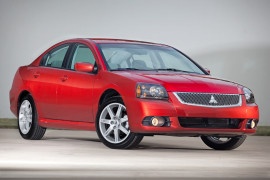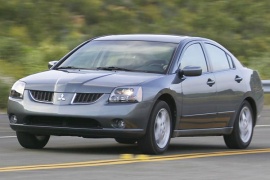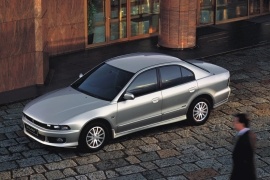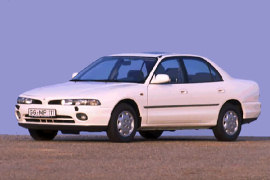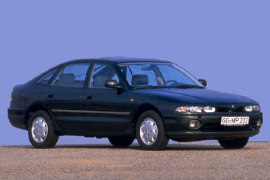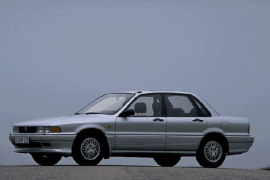MITSUBISHI Galant Models/Series Timeline, Specifications & Photos
First production year: 1988
Engines: Gasoline, Diesel
The facelifted Mitsubishi Galant made its appearance in 2008 at the Chicago Auto Show. The new version brought a new styling and improved performance.
The Galant offered four trim levels and three performance levels, offering the buyers a wide variety to choose from.
The engines mounted on the Galant were either a 4-cylinder or one of the two V6s. The Galant ES trim level, as well as the Sport Edition were powered by a 2.4-liter powerplant that developed 160 hp, mated with a standard 4-speed automatic transmission. Semi-manual shifting was also a standard feature, available due to the Mitsubishi Sportronic system.
The standard equipment on the ES included air conditioning, power windows, rear-seats heated ducts, cruise control, ABS, EBD and alloy wheels, while the optional features included leather upholstery, a better audio system, a sport steering wheel with audio controls, automatic climate control, 17-inch alloy wheels, heated front seats and other trim specific features.
On the other hand, the Sport Edition had extra fog lamps, 18-inch alloy wheels, climate control air conditioning and auto-dimming rear-view mirror. Of course, the leather package was also optional for this trim level.
For the more passionate drivers, the V6 version had a more powerful engine that developed 230 hp and was mated to a 5-speed automatic transmission. It was not a big difference between the Sport Edition and the V6, however, with greater power should come more efficient brakes, which also happened for the Galant which was equipped with larger front brakes.
The top of the range was the Railart trim level, as the Galant was equipped with a 3.8-liter V6 engine that developed 258 hp. The brakes and suspension were also upgraded to sustain the powerful engine. The Railart had every feature offered by the Galant, with a single one being an optional: 7-inch touchscreen and a rearview camera.
The Galant was highly competitive in its range, mostly due to its numerous features and its quality price ratio.
Mitsubishi introduced the ninth generation of the Galant on the North American market and was warmly welcomed by customers, despite its unusual design language.
In 2004, Mitsubishi tried to score big in front of American customers and produced its flagship sedan in Normal, Illinois. Moreover, the car was exported from there to several markets worldwide. While in the first production years, the car didn't manage to fulfill its customers' wishes, it upgraded the packages, and starting with 2007, it was a far better car.
Mitsubishi's design department shouldn't be awarded for creating such a bland-looking car, even though it tried. The headlights were rather squared but with a curved inner side. The grille was split into two halves, with a wide, vertical center slat where the badge was placed. After the 2007 facelift, that slat disappeared, leading to a much cleaner look. The sedan profile showed a slightly ascending beltline. At the back, the carmaker installed small taillights when compared to the rest of the rear end.
While the exterior designers looked like they were paid with lunch money, the interior designers looked like they got beefier salaries. The clean, two-tone design, with a touch-screen infotainment display placed atop the center stack that sported nicely done dials. Moreover, the bucket seats were bolstered just enough to provide a comfortable ride but still offer adequate side support during high-speed cornering. At the back, three passengers could sit on the bench, but the middle rear one had to deal with a harder center-section area.
Under the hood, Mitsubishi installed a choice of two engines: a 2.4-liter inline-four and a 3.8-liter V6. The latter was upgraded later on on the Ralliart versions and provided the performances a Galant needed to keep up with other Japanese carmakers.
Mitsubishi introduced the eighth generation of its mid-size lineup Galant, in 1997, trying to catch up with other Japanese automakers.
Starting with the fourth generation of the model, the Japanese mid-size vehicle was available only as a hatchback or as a sedan. Yet, the eighth generation model was designed only as a four-door sedan or a station wagon. Thus, the Japanese automaker tried to get a slice of this segment on both sides of the Atlantic.
At the front, the shark-nose design imagined by the Japanese designer Akinori Nakanishi sported a trapezoidal grille surrounded by a chromed trim. Its narrow headlights with corner-mounted turn signals and the tall wrapped-around front bumper created an aggressive appearance. From its profile, the Galant revealed a sporty shape, with a slightly ascending beltline and a flat trunk lid in the back.
Inside, the Galant offered seating for five with enough legroom for the rear outboard passengers and limited for the one seated in the middle due to the transmission tunnel. Mitsubishi used the same floor for the entire range, regardless of the front- or all-wheel drive systems. The clean layout of the dashboard featured a center stack where the automaker installed the controls for the HVAC unit.
Under the hood, Mitsubishi installed a choice of gasoline engines ranging between 136 hp and 163 hp. For selected markets, it offered a turbo-diesel version that provided 90 hp.
The eighth and last generation of the Galant VR-4 saw the launching lights in 1997, and it was a sports car dressed as a family sedan.
There were not too many family cars on the market that could get to 100 kph (62 mph) in less than six seconds and reach 240 kph (150 mph). Moreover, the Galant was packed with rally technologies and, thanks to its longer wheelbase, enough room for up to five adults.
With a styling heavily influenced by European sedans, the Galant showed a narrow, raked forward front area. Its wrapped-around bumper included an aerodynamic lower apron that sported the fog lights and another grille for the intercooler. Its three-box sedan shape featured curved lines and, in the back, a wing on the trunk confirmed the status of a sporty vehicle.
Inside, the carmaker installed a rather bland interior, with bucket seats at the front and a mix of grey and black dashboard. It didn't even try to install white dials for the speedometer or tachometer. The car offered room for three adults in the rear, although the middle passengers had to sit on the transmission tunnel.
Under the hood, Mitsubishi installed a 2.5-liter, twin-turbo V-6 engine. It was paired with a standard five-speed manual or a five-speed automatic transmission from Porsche (Tiptronic), which offered the possibility to change gears sequentially by pulling or pushing the gear lever. The most important part of the car was the drivetrain, which featured an all-wheel-drive system with an active rear differential (Active Yaw Control) available as an option. Moreover, the carmaker installed an all-wheel-steering system. The disc brakes in all corners and standard ABS with
Mitsubishi introduced the seventh generation of the Galant at the 1992 Tokyo Motor Show in Japan, and the evolution was evident.
When Mitsubishi started to draw the new model, it started from a blank sheet of paper, and that was not an overstatement. Gone were the unusual proportions of its predecessor, and the new model really showed like a mature model.
At the front, the car sported a split front fascia adorned in the middle by a narrower section and a vertical slat that supported the three-diamond badge. Its slim and wide headlights made the grille look mostly like nostrils. The primary cooling area was on the lower side of the bumper, where the automaker installed a broad, two-slat air intake. The sedan looked more like a pillar-less vehicle from its side since the B-pillar was concealed by more expansive windows and black trims. At the back, the trunk lid hosted a part of the taillights, creating a visual image of a wider vehicle.
Inside, Mitsubishi offered a spacious cabin for a mid-size sedan. The rear passengers had enough legroom thanks to the longer wheelbase than its predecessor. Yet, the bench was fit mostly for two occupants due to the tall transmission tunnel. In addition, the driver was spoiled with ample room and a clean layout for the center stack. On the safety side, the seventh generation of the Galant was also available with side bags.
Under the hood, the Japanese carmaker introduced a wide engine range with either four-cylinder or V6 powerplants. The top-of-the-range VR4 offered a sporty two-liter powerplant derived from the rally-spec engine and all-wheel drive system. Last but not least, all versions benefited from the multi-link independent suspension system in all corners, a first for an FWD car.
Mitsubishi launched the seventh generation of the Galant at the 1992 Tokyo Motor Show in Japan, and at the beginning of 1993, unveiled the five-door hatchback at the Dutch Motor Show.
Unlike its predecessor, which was built on the fifth-generation platform, the seventh iteration of this model was created from scratch. Thus, the automaker got rid of older technical limitations allowing it to make a much better car in terms of running costs, performance, and look.
At the front, the car sported a split front fascia adorned in the middle by a vertical slat that supported the three-diamond badge. Its slim and wide headlights made the grille look mostly like nostrils. The primary cooling area was on the lower side of the bumper, where the automaker installed a broad, two-slat air intake. The sedan looked more like a pillar-less vehicle from its side since the B-pillar was concealed by more expansive windows and black trims. In the five-door configuration, Mitsubishi used the same rear door panels but with different windows and frames. At the back, the sloped-down tailgate ended the vehicle with a sporty, coupe-like shape.
Inside, the Galant's seventh generation was very spacious. The rear passengers had enough legroom thanks to the longer wheelbase than its predecessor. Yet, the split-folding bench was fit mostly for two occupants due to the tall transmission tunnel. In addition, the driver was spoiled with ample room and a clean layout for the center stack. On the safety side, the seventh generation of the Galant was also available with side bags.
Mitsubishi installed a wide engine range for the Galant, depending on the market. Unlike its four-door sedan sibling, the Liftback bodywork was not available in the VR4 version.
The sixth generation of the Mitsubishi Galant was a surprising upgrade over its predecessor and became a true sports sedan, especially after it received some treatment from AMG.
Mitsubishi built the 1988 Galant on the same platform as its predecessor but restyled it completely. It also introduced new powertrains and became the official rally-car for the Japanese carmaker starting with 1988 in the VR4 version that featured an all-wheel-drive system and a turbocharged engine.
On the outside, the carmaker adopted a two-headlights design instead of the four as its predecessor and added orange, corner-mounted turn signals. The body-colored plastic, wrapped-around bumper sported a lower apron designed more for look than to increase the front downforce. Mitsubishi designed an ascending beltline carried over from its predecessor, but the rounded body panels and shaved edges were new. The greenhouse featured a third slim glass area behind the rear doors, providing more natural light for the rear passengers.
Inside, the Japanese carmaker installed a flat dashboard with a raised area with a set of vents, a digital clock, and the instrument cluster's sun visor. Since the carmaker struggled to get more market share, it provided more features fitted as standard than its competitors, including four power windows and an AC unit. At the bottom of the center stack, Mitsubishi installed a radio cassette player.
Under the hood, apart from the particular versions that featured all-wheel-drive and all-wheel steering, the rest of the range was quite common, with inline-four, naturally aspirated gasoline engines. A 1.8-liter turbo-diesel designed in-house was available for specific countries. The two-liter version received a special treatment and upgrade from AMG, which, in 1988, was not part of Mercedes-Benz. That made the Galant the only Japanese car ever tuned by the famous German tuner.
